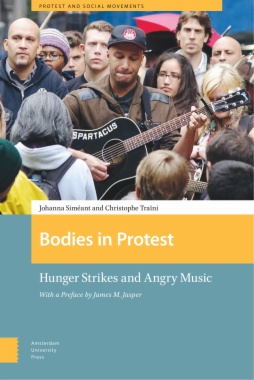Research on social movements has historically focused on the traditional weapons of the working class, especially labor strikes and street demonstrations-but everyday actions, such as eating or singing, which can also be turned into a means of protest, have yet to be fully explored. Originally published as La grève de la faim by Johanna Siméant and La musique en colère by Christophe Traïni, Bodies in Protest is an interdisciplinary and comparative history of these modes of action that reveals how hunger strikes and music ranging from gospel songs to rock anthems can efficiently convey political messages and mobilize the masses. Common to both approaches, the chapters show, is a direct appeal to the emotions and a reliance on the physical, concrete language of the human body.
- Cover
- Table of contents
- Preface
- Hunger strikes
- Johanna Siméant
- Introduction
- 1. From fast to hunger strike
- Fasting and protest in history
- A 20th-century political form of action
- Gandhi and fasting
- From the Algerian War to the banalisation of the 1960s-1970s
- 2. An atypical and irrational method?
- An ‘individual’ method of action?
- An irrational method of action?
- A residual method of action?
- 3. The meaning of bodily violence
- The limits of the culturalist hypothesis
- Violence, non-violence and militant traditions
- Testify and denounce
- Public denunciation of injustice
- The authorities as responsible
- Challenges to the authenticity of engagement
- Refusing the grip of power
- The body in struggles over status and recognition
- 4. Hunger strikes, media and politics
- Hunger strike, political regimes and the state
- Faced with the state, public opinion and humanity
- Different tolerance of protest by different states
- In the media spotlight
- Mobilising media: Spectacular and humanitarian
- Reticence or engagement by journalists
- Media coverage and reception of hunger strikes
- Hunger strikes in repertoires of protest action
- Repertoires and ‘comparative advantages’?
- Criticism of the legitimacy of the use of hunger strikes
- Temporality of the use of hunger strikes and protest cycles
- 5. Hunger strikers and injustice
- ‘Little people’ confronting the machine
- Victims
- Struggles for status and the world of work
- ‘Institutional dissidents’
- Faced with political repression
- Pursuing the struggle: Politicising everyday life in prison
- Disarmed opponents, exemplary opponents
- Becoming fully recognised citizens: Harkis, refugees, sans papiers
- In the name of peace and non-violence
- 6. When hunger strikes arise
- Beginning a hunger strike
- Choosing a site
- Burning bridges
- The time of the strike
- Running risks, holding on
- Being credible
- The escalation process and preventing defection
- Repressing the strike
- Force-feeding in prison and the role of the media
- Divide, accuse and sap the credibility of supporters
- Police and military intervention
- Letting them die, making them martyrs
- Ending the strike
- Negotiate or persist?
- Management of feeding and life after the strike
- Conclusion
- Select bibliography
- Angry music
- Christophe Traïni
- Introduction
- Well-orchestrated protest
- 1. Protest put to music
- The weapons of musical polysemy
- Between contemplation, contestation and legitimation
- 2. Amplifying protest
- Dictating adequate emotions
- Exalting a ‘we’ in movement
- Criticising the authorities, avoiding censorship
- Promoting moral values
- Attracting support and mobilising resources
- 3. Music and political tactics
- Subversion and modification of musical conventions
- From repression to political instrumentalisation
- From the stage to the political arena
- 4. Protest, art and commerce
- Musical outlets and youth ‘moratoriums’
- Competing artistic vocations
- Bohemian art
- The ‘Parnassian’ position
- Commerce and profit
- Conclusion
- Harmonies and cacophonies
- Select bibliography
- Index
- List of tables and figures
- Hunger strikes
- Table 1 – Hunger strikes in France, documented in Le Monde, 1971-1992
- Table 2 – Type of demands of hunger strikes in France (outside prison)
- Table 3 – Sites of hunger strikes in France between 1971 and 1992
- Angry music
- Table 1 – Musical communication and emotional expression
- Table 2 – The contribution of musical devices to protest initiatives
- Table 3 – A typology of the social vocations attributed to artists
- Figure 1 – The social uses of musical devices

